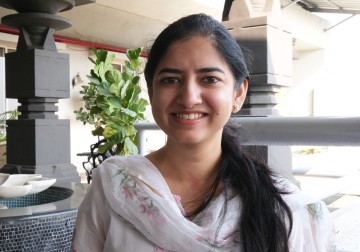Keratoconus is an eye condition where the gradual thinning of the cornea, the clear, dome-like front part of the eye, causes it to become deformed and protrude like a cone. Keratoconus manifests among teenagers and young adults, and if left untreated, it can lead to vision impairment. While the development and management of keratoconus is well-studied, data indicating the prevalence of keratoconus and its etiology in India is scarce.
Dr. Rashmi Deshmukh, consultant ophthalmologist and scientist at LVPEI, discusses her latest research paper that uses LVPEI’s electronic medical records to assess the hospital-based prevalence, demographics, and clinical presentation of keratoconus among Indians.
What are your areas of medical practice and research interests?
I specialize in cornea and the anterior segment of the eye. I completed fellowships in refractive errors, cornea, and ocular surface disorders. My principal areas of interest in research are keratoconus and other corneal ectasias.
Do you remember the first case of Keratoconus that you treated at LVPEI? What got you interested in Keratoconus as a research topic?
After I joined LVPEI in 2021, the first case of keratoconus I remember treating was a 13-year-old girl with vernal keratoconjunctivitis, and she kept rubbing her eyes. We used collagen cross-linking (CXL) as a treatment for her. CXL stiffens the cornea and prevents further progression of keratoconus. After CXL, she was prescribed scleral contact lenses for her vision rehabilitation. Thankfully, her vision improved.
Keratoconus is common in Asia, including India. It affects young people, usually between the ages of 10 to 30 years, who are otherwise systemically healthy. Although eye rubbing is the most common risk factor, it is unclear whether there is an already existing genetic abnormality that predisposes certain individuals to developing keratoconus. Nevertheless, there is currently no cure for keratoconus. The only treatment we have can simply halt the progression of the disease. As medical professionals, we need to do more than just halt its progression and I want to work towards improving outcomes.
What are the risk factors and current management strategies for keratoconus?
Frequent, abnormal eye rubbing is a major risk factor for keratoconus. This can be habitual eye rubbing or from itching due to allergies or infections. Keratoconus is also associated with genetic abnormalities and can progress in cases of thyroid disorder, hormone replacement therapy, and pregnancy.
The prevalence of keratoconus differs greatly between nations and even between different ethnicities. Why is there such a high variation?
The climate is affecting the prevalence. The equatorial belt has higher incidence of allergic diseases, which includes those of the eye. This leads to a higher frequency of eye rubbing, which leads to keratoconus in more people.
Secondly, western nations have more awareness. It is not that they do not have keratoconus, but they seek treatment early. Places like rural India neither have the awareness, nor do they have the tools—like corneal tomography—needed to detect keratoconus. Most patients believe they only have a refractive error.
The study found that men are eight times more likely to have keratoconus. What makes men more susceptible than women?
Keratoconus has no genetic predisposition towards any gender. However, males are more likely to play outside and leave the house, which can raise their risk of ocular allergies and infections. That is the most popular theory, but no research has been done to support it.
The study also found that people from upper-middle class were more susceptible to keratoconus? Is it a function of LVPEI’s data, or is there a larger picture: for example, does lifestyle impact keratoconus?
That was an interesting finding. It may be because the upper-middle class live in urban areas, are more educated, and have more wealth. Consequently, they have easier access to medical facilities and are more likely to see them if they notice even a slight decline in their visual acuity. People from lower socioeconomic strata do not have the financial means or the awareness. I do not think the prevalence of keratoconus is higher among the upper-middle class, but more cases are being reported.
What would be the impact of this study regarding keratoconus management and research in your work, or at LVPEI?
The biggest impact will be raising awareness that most keratoconus patients do not need a corneal transplant. In fact, most cases can be treated with corrective spectacles or contact lenses. A certain proportion of patients require CXL, which is still a far less invasive procedure than a corneal transplant.
What are some other projects that you are working on?
The current study is based on eight years of data. We have also collected 30 years of data, which goes back to LVPEI's inception. The goal is to look at the overall trends in keratoconus presentation, treatment preferences, and practice patterns in our network over three decades. A lot has changed in 30 years; we have moved to contact lenses and CXL over corneal transplant, we have access to better corneal tomography, and so on. Despite that, there are doctors who still prefer traditional treatments over newer ones like CXL in conjunction with photorefractive keratectomy or special contact lenses, which are expensive and require the expertise of a specialized optometrist. It is necessary to know these trends so that standardized practice pattern guidelines can be created.
Dr. Rashmi Deshmukh spoke to Sayantan Mitra, Science Writer, LVPEI. Read more about her research here.
Citation
Das AV, Deshmukh RS, Reddy JC, et al. Keratoconus in India: Clinical presentation and demographic distribution based on big data analytics. Indian J Ophthalmol. 2024;72(1):105-110



